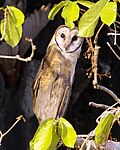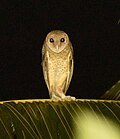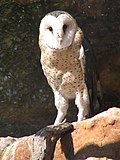Superregnum: Eukaryota
Regnum: Animalia
Subregnum: Eumetazoa
Cladus: Bilateria
Cladus: Nephrozoa
Superphylum: Deuterostomia
Phylum: Chordata
Cladus: Craniata
Subphylum: Vertebrata
Infraphylum: Gnathostomata
Superclassis: Tetrapoda
Cladus: Reptiliomorpha
Cladus: Amniota
Classis: Reptilia
Cladus: Eureptilia
Cladus: Romeriida
Subclassis: Diapsida
Cladus: Sauria
Infraclassis: Archosauromorpha
Cladus: Crurotarsi
Divisio: Archosauria
Subsectio: Ornithodira
Subtaxon: Dinosauromorpha
Cladus: Dinosauria
Ordo: Saurischia
Cladus: Theropoda
Cladus: Neotheropoda
Infraclassis: Aves
Cladus: Euavialae
Cladus: Avebrevicauda
Cladus: Pygostylia
Cladus: Ornithothoraces
Cladus: Euornithes
Cladus: Ornithuromorpha
Cladus: Ornithurae
Cladus: Carinatae
Parvclassis: Neornithes
Cohors: Neognathae
Ordo: Strigiformes
Familia: Tytonidae
Genus: Tyto
Species: T. alba – T. almae – T. aurantia – T. capensis – T. deroepstorffi – T. furcata – T. glaucops – T. inexspectata – T. javanica – T. longimembris – T. manusi – T. multipunctata – T. nigrobrunnea – T. novaehollandiae – T. rosenbergii – T. sororcula – T. soumagnei – T. tenebricosa
Name
Tyto Billberg, 1828
References
Synopsis faunae Scandinaviae 1 (2): tab.A.
Suárez, W. & Olson, S.L. 2015. Systematics and distribution of the giant fossil barn owls of the West Indies (Aves: Strigiformes: Tytonidae). Zootaxa 4020(3): 533–553. DOI: 10.11646/zootaxa.4020.3.7. Preview (PDF) Reference page.
Vernacular names
azərbaycanca: Alabayquş
български: Забулени сови
বাংলা: টাইটো
Deutsch: Schleiereulen
Ελληνικά: Τυτώ
English: Barn Owls & Masked Owls
Esperanto: Turstrigo
español: Lechuza
فارسی: جغدهای انبار
suomi: Tornipöllöt
français: Effraie
Frysk: Goudûlen
latviešu: Plīvurpūces
polski: Płomykówki
русский: Сипухи
ไทย: นกแสก
Türkçe: Peçeli baykuş
українська: Сипуха
Tiếng Việt: Chi Cú lợn
中文: 草鸮属
Tyto is a genus of birds consisting of true barn owls, grass owls and masked owls that collectively make up all the species within the subfamily Tytoninae of the barn owl family, Tytonidae.
Contents
1 Taxonomy
1.1 Extant species
1.2 Extinct species
1.3 Former species
2 Description
3 Footnotes
4 References
5 External links
Taxonomy
The genus Tyto was introduced in 1828 by the Swedish naturalist Gustaf Johan Billberg with the western barn owl as the type species.[1][2] The name is from the Ancient Greek tutō meaning "owl".[3]
Throughout their evolutionary history, Tyto owls have shown a better capability to colonize islands than other owls. Several such island forms have become extinct, some long ago, but some in comparatively recent times. A number of insular barn owls from the Mediterranean and the Caribbean were very large or truly gigantic species.
Extant species
Seventeen species are recognized:[4]
| Image | Common name | Scientific name | Distribution |
|---|---|---|---|
 |
Greater sooty owl | Tyto tenebricosa | Australia |
 |
Lesser sooty owl | Tyto multipunctata | Australia |
 |
Minahassa masked owl | Tyto inexspectata | Sulawesi, Indonesia |
| Taliabu masked owl | Tyto nigrobrunnea | Sula Islands, Maluku, Indonesia | |
| Moluccan masked owl | Tyto sororcula | south Moluccas of Indonesia | |
| Manus masked owl | Tyto manusi | Manus Island in the Admiralty Islands | |
| Golden masked owl | Tyto aurantia | the island of New Britain, Papua New Guinea | |
 |
Australian masked owl | Tyto novaehollandiae | Southern New Guinea and the non-desert areas of Australia. |
 |
Sulawesi masked owl | Tyto rosenbergii | the Indonesian islands of Sulawesi, Sangihe and Peleng |
| Red owl | Tyto soumagnei | Madagascar | |
 |
Western barn owl | Tyto alba | Eurasia and Africa. |
 |
American barn owl | Tyto furcata | the Americas |
 |
Eastern barn owl | Tyto javanica | southeast Asia and Australasia. |
 |
Andaman masked owl | Tyto deroepstorffi | southern Andaman Islands |
 |
Ashy-faced owl | Tyto glaucops | Hispaniola (Haiti and the Dominican Republic). |
 |
African grass owl | Tyto capensis | southern Congo and northern Angola to the central coast of Mozambique and the other centred on South Africa from the Western Cape north to the southern extremities of Zimbabwe, Botswana and Mozambique. |
 |
Eastern grass owl | Tyto longimembris | eastern, southern and southeast Asia, parts of New Guinea, Australia (mainly in Queensland) and the western Pacific |
Extinct species
Known from ancient fossils
Tyto sanctialbani (Middle - Late Miocene of Central Europe) - formerly in Strix; includes T. campiterrae
Tyto robusta (Late Miocene/Early Pliocene of the Gargano Peninsula, Italy)
Tyto gigantea (Late Miocene/Early Pliocene of the Gargano Peninsula, Italy)
Tyto balearica (Late Miocene - Middle Pleistocene of the west-central Mediterranean)
Tyto mourerchauvireae (Middle Pleistocene of Sicily, Mediterranean)
Tyto jinniushanensis (Pleistocene of Jing Niu Shan, China)
Tyto sp. 1
Tyto sp. 2
Late prehistoric extinctions usually known from subfossil remains
Fossils of Tyto cavatica
Fossil of Tyto ostologa
Mussau barn owl (Tyto cf. novaehollandiae) found in Mussau[5]
New Ireland greater barn owl (Tyto cf. novaehollandiae) found in New Ireland
New Ireland lesser barn owl (Tyto cf. alba/aurantiaca) found in New Ireland[5]
New Caledonian barn owl (Tyto letocarti) found in New Caledonia - tentatively placed here
Puerto Rican barn owl (Tyto cavatica) found in Puerto Rico - may still have existed up to 1912; possibly a subspecies of the ashy-faced owl (Tyto glaucops)
Noel's barn owl (Tyto noeli) found in Cuba
Rivero's barn owl (Tyto riveroi) found in Cuba
Cuban barn owl (Tyto sp.) found in Cuba
Hispaniolan barn owl (Tyto ostologa) found in Hispaniola
Bahaman barn owl (Tyto pollens) found in Little Exuma, New Providence, and maybe Andros Island, the Bahamas - may have survived into the 16th century
Barbuda barn owl (Tyto neddi) found in Barbuda and possibly Antigua
Maltese barn owl (Tyto melitensis) found in Malta - formerly in Strix; possibly a paleosubspecies of Tyto alba
Former species
A number of owl fossils were at one time assigned to the present genus, but are nowadays placed elsewhere. While there are clear differences in osteology between typical owls and barn owls, there has been parallel evolution to some degree and thus isolated fossil bones cannot necessarily be assigned to either family without thorough study. Notably, the genus Strix has been misapplied by many early scientists as a "wastebasket taxon" for many owls, including Tyto.[6]
Tyto antiqua (Late Eocene/Early Oligocene of Quercy? - Early Miocene of France) was a barn owl of the prehistoric genus Prosybris; this taxon might be a nomen nudum, as the species was originally described in Strix, this requires confirmation[7]
Tyto edwardsi (Late Miocene of Grive-Saint-Alban, France) was a strigid owl, but has not yet been reliably identified to a genus; it might belong in Strix or the European Ninox-like group .
Tyto ignota (Middle Miocene of Sansan, France) was a strigid owl of unclear affinities; while it might belong into Strix, this requires confirmation[7]
"TMT 164", a distal left tarsometatarsus of a supposed Tyto from the Middle Miocene Grive-Saint-Alban (France); might also belong in Prosybris, as it is similar to Tyto antiqua[8]
Description
They are darker on the back than the front, usually an orange-brown colour, the front being a paler version of the back or mottled, although there is considerable variation even amongst species. Tyto owls have a divided, heart-shaped facial disc, and lack the ear-like tufts of feathers found in many other owls. Tyto owls tend to be larger than bay owls. The name tyto (τυτώ) is onomatopeic Greek for owl.
Footnotes
Billberg, Gustaf Johan Billberg (1828). Synopsis faunae Scandinaviae. Tome 1, Part 2 Aves. Table.
Peters, James Lee, ed. (1940). Check-List of Birds of the World. Volume 4. Cambridge, Massachusetts: Harvard University Press. p. 77.
Jobling, James A. (2010). The Helm Dictionary of Scientific Bird Names. London: Christopher Helm. p. 394. ISBN 978-1-4081-2501-4.
Gill, Frank; Donsker, David, eds. (2017). "Owls". World Bird List Version 7.3. International Ornithologists' Union. Retrieved 28 August 2017.
Steadman (2006)
Mlíkovský (2002): p.217
Mlíkovský (2002)
Ballmann (1969)
References
Ballmann, Peter (1969). Les Oiseaux miocènes de la Grive-Saint-Alban (Isère) [The Miocene birds of Grive-Saint-Alban (Isère)]. Geobios 2: 157–204. [French with English abstract] doi:10.1016/S0016-6995(69)80005-7 (HTML abstract)
Bruce, M.D. (1999). Family Tytonidae (Barn-owls). In: del Hoyo, J.; Elliott, A. & Sargatal, J. (eds): Handbook of Birds of the World Vol. 5 (Barn-owls to Hummingbirds): 34–75, plates 1–3. Lynx Edicions, Barcelona. ISBN 84-87334-25-3
Mlíkovský, Jirí (2002). Cenozoic Birds of the World, Part 1: Europe. Ninox Press, Prague. ISBN 80-901105-3-8 PDF fulltext Archived 2011-05-20 at the Wayback Machine
Olson, Storrs L. (1985). Section IX.C. Strigiformes. In: Farner, D.S.; King, J.R. & Parkes, Kenneth C. (eds.): Avian Biology 8: 129–132. Academic Press, New York.
Steadman, David William (2006). Extinction and Biogeography of Tropical Pacific Birds. University of Chicago Press. ISBN 0-226-77142-3.
Retrieved from "http://en.wikipedia.org/"
All text is available under the terms of the GNU Free Documentation License

